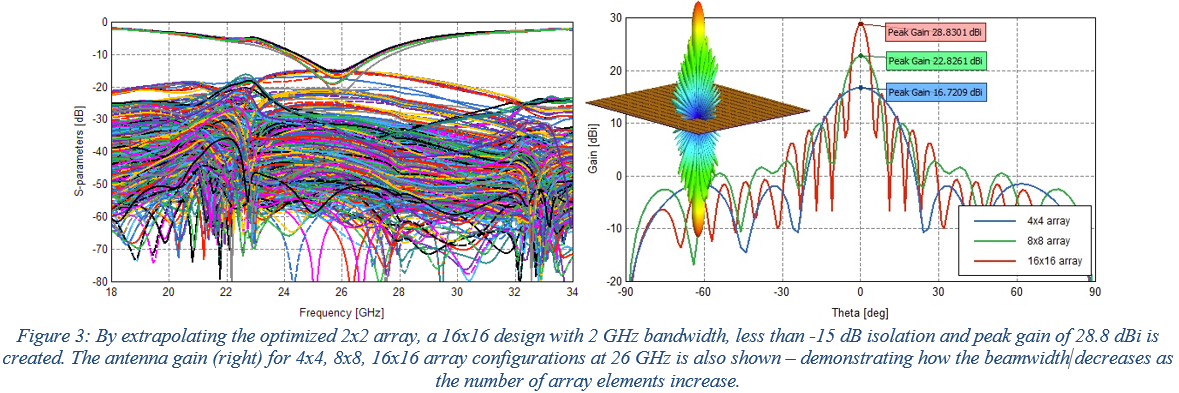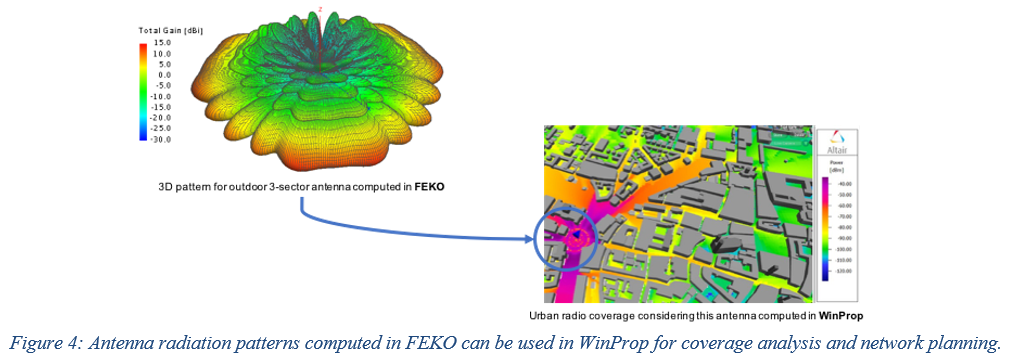Antenna Design for 5G Communications
With the rollout of the 5th generation mobile network around the corner (scheduled for 2020 [wiki/5G]), technology exploration is in full swing. The new 5G requirements (e.g. 1000x increase in capacity, 10x higher data rates, etc.) will create opportunities for diverse new applications, including automotive, healthcare, industrial and gaming. But to make these requirements technically feasible, higher communication frequencies are needed. For example, the 26 and 28 GHz frequency bands have been allocated for Europe and the USA respectively – more than 10x higher than typical 4G frequencies. Other advancement will include carrier aggregation to increase bandwidth and the use of massive MIMO antenna arrays to separate users through beamforming and spatial multiplexing.
Driving Innovation Through SimulationThe combination of these technology developments will create new challenges that impact design methodologies applied to mobile and base station antennas currently. Higher gain antennas will be needed to sustain communications in the millimeter wavelength band due to the increase in propagation losses. While this can be achieved by using multi-element antenna arrays, it comes at the cost of increased design complexity, reduced beamwidth and sophisticated feed circuits.
Simulation will pave the way to innovate these new antenna designs through rigorous optimization and tradeoff analysis. Altair’s FEKO™ is a comprehensive electromagnetic simulation suite ideal for these type of designs: offering MoM, FEM and FDTD solvers for preliminary antenna simulations, and specialized tools for efficient simulation of large array antennas.
Mobile DevicesIn a mobile phone, antenna real estate is typically a very limited commodity, and in most cases, a tradeoff between antenna size and performance is made. In the millimeter band the antenna footprint will be much smaller, and optimization of the antenna geometry will ensure the best antenna performance is achieved for the space that is allocated, also for higher order MIMO configurations.
At these frequencies, the mobile device is also tens of wavelengths in size and the antenna integration process now becomes more like an antenna placement problem – an area where FEKO is well known to excel. When considering MIMO strategies, it is also easier to achieve good isolation between the MIMO elements, due to larger spatial separation that can be achieved at higher frequencies. Similarly, it is more straightforward to achieve good pattern diversity strategies.
Base StationFEKO’s high performance solvers and specialized toolsets are well suited for the simulation massive MIMO antenna arrays for 5G base stations. During the design of these arrays, a 2x2 subsection can be optimized to achieve good matching, maximize gain and minimize isolation with neighboring elements –a very efficient approach to minimize nearest neighbor coupling. The design can then be extrapolated up to the large array configurations for final analysis. Farming of the optimization tasks enables these multi-variable and multi-goal to be solved in only a few hours. Analysis of the full array geometry can be efficiently solved with FEKO’s FDTD or MLFMM method: while FDTD is extremely efficient (1.5 hrs for 16x16 planar array), MLFMM might also be a good choice depending on the specific antenna geometry.
The 5G Channel and Network DeploymentThe mobile and base station antenna patterns that are simulated in FEKO, can used in WinProp™ for high-level system analysis of the 5G radio network coverage and to determine channel statistics for urban, rural and indoor scenarios.
WinProp is already extensively used for 4G/LTE network planning. However, the use cases for 5G networks will be even more relevant largely due to the different factors that occur in the millimeter band. These include higher path loss from atmospheric absorption and rainfall, minimal penetration into walls and stronger effects due to surface roughness.
In addition to being able to calculate the angular and delay spread, WinProp also provides a platform to analyze and compare the performance of different MIMO configurations while taking beamforming into account.
The Road to 5GWhile some of the challenges that lie ahead to meet the 5G requirements may still seem daunting, simulation can already be used today to develop understanding and explore innovative solutions. FEKO offers comprehensive solutions for device and base station antenna design, while WinProp will determine the requirements for successful network deployment.










